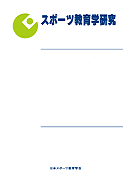All issues

Volume 34 (2014)
- Issue 2 Pages 1-
- Issue 1 Pages 1-
Volume 34, Issue 2
Displaying 1-5 of 5 articles from this issue
- |<
- <
- 1
- >
- >|
-
— Focusing on the Times Allotted to Each Episode of Teaching and Student’s Awareness of Teacher’s Feedback —Eiichiro FUKAMI, Yuichiro TANAKA, Yoshinori OKAZAWA2015 Volume 34 Issue 2 Pages 1-16
Published: February 28, 2015
Released on J-STAGE: June 11, 2015
JOURNAL FREE ACCESSThe purpose of this study is to identify characteristics of effective teaching strategy through a comparison of experienced and novice teachers’ teaching behavior in ball-game units in elementary school physical education.
In the study, we analyze various elements in the teaching units in order to identify characteristics of teacher management techniques and teacher-student interaction. Secondly, we analyze “students’ perception of teacher advice” in order to clarify how advice were received by students.
Our purpose is to propose effective teaching skills for novice teachers to allow them to perform more like experienced teachers early on.
The study is based on case studies of two ball-game units (a total of 16 classes) taught by two elementary school teachers.
The main findings of the study were as follows: The experienced teacher dedicated much time to independent motor skill learning throughout the unit, and interacted with each student, giving a high amount of corrective/affirmative feedback concerning student motor skills. Advice was perceived as useful by most students. Furthermore, the experienced teacher establishes learning discipline in the early stages of the unit and in order to secure time for independent motor skill learning.View full abstractDownload PDF (1153K) -
— Based on Education Guidance Principle from 1913 to 1949 —Rio NAKAMICHI2015 Volume 34 Issue 2 Pages 17-28
Published: February 28, 2015
Released on J-STAGE: June 11, 2015
JOURNAL FREE ACCESSIn Japan, school education is governed by Education Guidance Principle (EGP) of Ministry of Education, Culture, Sports, Science and Technology (MEXT). The name of EGP for elementary school physical education was changed from “Teaching guide of school gymnastics” (1913) before WWII to “National teaching guide of school physical training” (1942) during the war and “EGP -Book of physical education-Draft” (1949) after the war.
The purpose of this study is to analyze the allocation of ball game-teaching materials in the above Teaching guides/EGP from 1913 to 1949 and clarify its historical change based on the original sources.
The main results are as follows;
1) No term of “ball games” appeared in the 1913-Teaching guide, but a kind of its contents was included in a category of competitive games/plays. The object of this category was an activity which a lot of students simultaneously do it together obeying the rule toward a goal.2) When 1913-Teaching guide was revised in 1926, an expression of “ball games” was clearly used to classify teaching materials for the first time. 3) In 1942-Teaching guide, teaching methods of “ball games” were specifically written. However the explanation of the methods including “Try hard silently” or “Do it quietly” is questionable in terms of the essential aims of “ball games” or “sport” based on the teaching philosophy that they have to be filled with fun, enjoyment or pleasure and so on. 4) In 1949-EGP-Draft after the war, “ball games” as teaching material was positively allocated in curriculum in order to develop the quality or ability of students in order to spend a democratic life and to expect the possibility that students compete under equal condition each other as the post-war educational policy. 5) Surveying the Teaching guides/EGP between 1913 and 1949, it could be partially emerged how “game/play using ball” changed to “ball games” as one of competitive sports using ball/balls.View full abstractDownload PDF (565K)
-
[in Japanese]2015 Volume 34 Issue 2 Pages 29-33
Published: February 28, 2015
Released on J-STAGE: June 11, 2015
JOURNAL FREE ACCESSDownload PDF (281K) -
Mayumi Ya-Ya Yamamoto2015 Volume 34 Issue 2 Pages 35-37
Published: February 28, 2015
Released on J-STAGE: June 11, 2015
JOURNAL FREE ACCESSDownload PDF (319K) -
[in Japanese]2015 Volume 34 Issue 2 Pages 39-44
Published: February 28, 2015
Released on J-STAGE: June 11, 2015
JOURNAL FREE ACCESSDownload PDF (751K)
- |<
- <
- 1
- >
- >|